Also known as the Thatcher Cemetery,
but is not to be confused with the Thatcher Burying Ground in Sergeantsville.
One of the most interesting private cemeteries in Delaware Township lies hidden among the trees on an old farm located near Routes 523 and 579. In 1931, Egbert T. Bush wrote that half of the cemetery was located on the Thatcher farm and half on a farm owned by A. J. Dalrymple. Bush identified a few of the stones, and on a visit in 1995 I found a few more, for a total of 18 gravestones with initials.1

I have taken the liberty of naming this cemetery the Kitchen Family cemetery, even though no stone has been found there with the name Kitchen. In fact, none of the stones have a name spelled out; they are all labeled with initials. Six of the eighteen stones that have been found show the initial K. Another six end with T., probably for the Thatcher family, although some could belong to the Trout family, who also owned land nearby. It is surprisingly difficult to match initials on gravestones with known residents of Delaware Township in the 18th century. It serves as a reminder that, because of poor record keeping, we know very little about the families of that time period.
Hiram Deats wrote in a letter of 1835: “The Kitchen family settled about 3 miles southwest of Flemington about 200 years ago but left little impression on the records; The family graveyard is on the Johnson Dalrymple farm in Sand Brook.”2
You will sometimes read of people being buried “in Sand Brook,” yet their graves cannot be found in the cemetery located next to the Sand Brook church. It seems that 100 years ago or more, people considered the Kitchen cemetery as part of Sand Brook. And there is another cemetery just south of the village, known as the Rake Family Cemetery which also is claimed as being “at Sand Brook.” Both the Kitchen and the Rake Family Cemeteries predate the cemetery next to the church.
The Kitchen cemetery has a stone wall surrounding it (now much deteriorated), and just beyond the wall were several gravestones without markings. Some have speculated that slaves were buried there. I have my doubts, since most of the Hunterdon slaveowners were Dutch and there were no Dutch families in this immediate vicinity. Also, local slaveowners did not own many slaves, not enough to explain the large number of stones found by Egbert T. Bush.
Another theory goes that soldiers in the Revolutionary War are buried there. Jonathan M. Hoppock claimed there was a three-day encampment of the Continental Army on the farm of Hiram Hoppock near Sand Brook, and some of the soldiers died of illness while there. Unfortunately, nothing has been found so far to back up this story.
All of the stones in the Kitchen Cemetery have similar carving, suggesting the same person carved many of these mid-18th century stones. Some stones have more carefully carved initials that might have been done at a later date. As for the persistent use of initials rather than names, it suggests that the people here might have been Quakers.
Possible Kitchen Stones
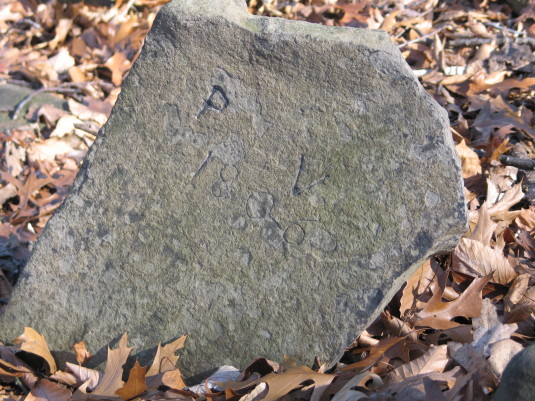 According to the old inventories, members of the Kitchen family, if indeed that’s who they are, have stones marked B. K.; I. K.; P. K. 1806; R. K.; S. K. B Y I U 28 1761; and T. K. / D M 20 / 1764. Of all these (presumably) Kitchen stones, I only found three, and one of them, “P. K. 1806” turns out not to be a K stone at all. It says pretty clearly “P. V. / 1806.”
According to the old inventories, members of the Kitchen family, if indeed that’s who they are, have stones marked B. K.; I. K.; P. K. 1806; R. K.; S. K. B Y I U 28 1761; and T. K. / D M 20 / 1764. Of all these (presumably) Kitchen stones, I only found three, and one of them, “P. K. 1806” turns out not to be a K stone at all. It says pretty clearly “P. V. / 1806.”
So who was P. V. ? I don’t really know. The only possibility I have is Peter Vandolah, son of Hendrick Vandolah and Sarah Johnson. This Peter was born about 1740. Records show that in 1792 he owned land next to a farm mortgaged by Samuel and Mary Hunt to Amos Thatcher, but that was closer to Sandy Ridge. Seems unlikely, especially since Peter Vandolah is said to have moved to Washington Twp., PA.
The Kitchen Family first appears in Delaware Township in the 1730s. Henry Kitchen (c.1680-1745) and wife Ann Wheeler were present here about that time. They had at least five sons, who were probably all born before 1730. I do not know if they had any daughters. Henry wrote his will in 1745 and named only his five sons. Henry bequeathed his “old plantation in Amwell bought of Samuel Green” to his youngest son Richard. Samuel Green was one of the first people to buy large tracts of land in Delaware Township.
I mentioned before the possibility that the people in this cemetery may have been Quakers. I do not know if Henry Kitchen was a Quaker, but his wife Ann Wheeler was the daughter of Gilbert Wheeler, an early Quaker settler in Bucks County. Perhaps it was her influence that determined how the stones were carved.
There is no H. K. or A. K. here for Henry and Ann Kitchen, but there is an R. K. which could be for their son Richard, although there is some evidence he had moved to Hackettstown by 1756. None of the other sons seems to be buried here, or if they are, their stones have not survived. (Note: This R. K. stone may still be in the graveyard, but I did not find it.)
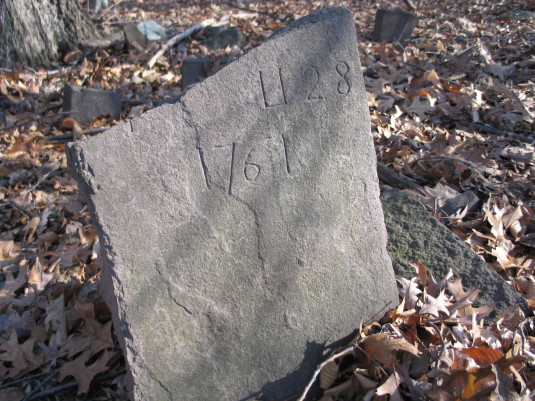 This stone—S. K. / B Y / I / U 28 / 1761—is very intriguing. It seems to mean “S K [itchen] d. June 28, 1761.” At first I thought it might be Henry and Ann’s son Samuel Kitchen who was the miller of Sand Brook, born about 1710 or 1720. But he did not die until 1773, so this “S K” is not him. He and wife Mary had nine children. She died in 1805. If she was buried here, her stone is gone. Of their seven daughters, two of them married Rockafellars: Anna married Henry Rockafellar and Margaret married John Rockafellar. A daughter Rebekah Kitchen might be the “R.K.” None of the other daughters match. Samuel’s sons were Henry and William, but I have no information on them. They probably left Hunterdon Co. around the time of the Revolution.
This stone—S. K. / B Y / I / U 28 / 1761—is very intriguing. It seems to mean “S K [itchen] d. June 28, 1761.” At first I thought it might be Henry and Ann’s son Samuel Kitchen who was the miller of Sand Brook, born about 1710 or 1720. But he did not die until 1773, so this “S K” is not him. He and wife Mary had nine children. She died in 1805. If she was buried here, her stone is gone. Of their seven daughters, two of them married Rockafellars: Anna married Henry Rockafellar and Margaret married John Rockafellar. A daughter Rebekah Kitchen might be the “R.K.” None of the other daughters match. Samuel’s sons were Henry and William, but I have no information on them. They probably left Hunterdon Co. around the time of the Revolution.
I was a little heartbroken when I found this stone, because the top was knocked off, with only “U 28 / 1761” left visible.
Wheeler Kitchen, a son of Henry and Ann, and brother of Samuel, had a daughter Sarah Kitchen, but Wheeler Kitchen and wife Mary had moved to Greenwich Twp. in (then) Sussex Co. about the time of their marriage, around the 1750s, so it is not likely that S. K. was their daughter.
There were two men named Kitchen in Amwell (Delaware) Twp. who might have been brothers of Henry Kitchen. One was James Kitchen (c.1700-1761), who married Elizabeth Furman (c.1700-aft 1765) about 1725. The I. K. could be James Kitchen, as J’s were written as I’s in the 18th century. The stone is located between “T. K.” (died 1764) and “S. K.” (died 1761). I do not know exactly where James and Elizabeth Kitchen were living, but they did own land in Sergeantsville in 1740. Perhaps S. K. was an unknown sibling of James and Henry Kitchen.
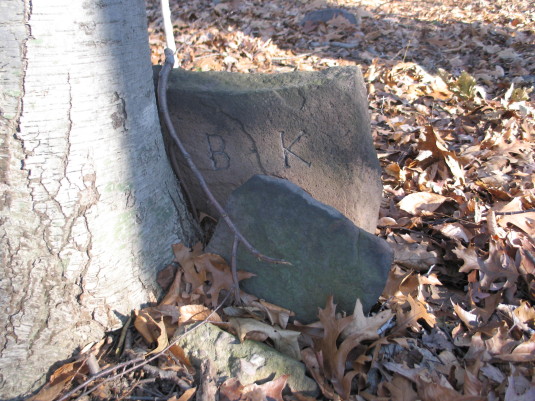 James and Elizabeth had at least four children. Son Benjamin was born about 1727 and died before 1769. James Kitchen wrote his will in 1745 and named his oldest son Benjamin, who was a minor. “B. K.” could be Benjamin Kitchen.
James and Elizabeth had at least four children. Son Benjamin was born about 1727 and died before 1769. James Kitchen wrote his will in 1745 and named his oldest son Benjamin, who was a minor. “B. K.” could be Benjamin Kitchen.
Henry and James Kitchen had a brother Thomas Kitchen who was executor of James’ will in 1745. Land that Thomas Kitchen owned was eventually sold to the Buchanan family. Thomas married Sarah Lambert, daughter of John Lambert and Abigail Bumstead. I do not have a death date for his wife Sarah. But she seems the best candidate for the “S. K.”
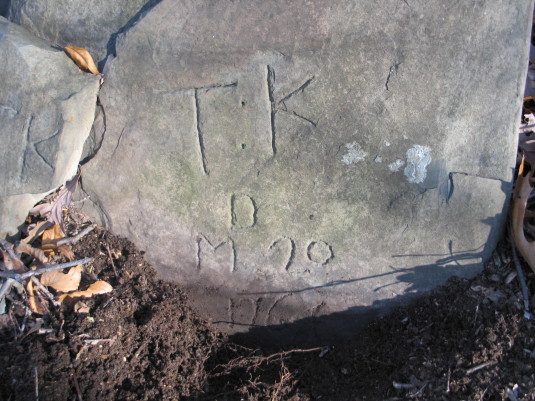 Thomas Kitchen’s will was recorded in 1764, so it seems likely that this stone, “T. K., D M 20 / 1764” belongs to him. Decoded, it means T. K. died March (or May) 20, 1764. I’m happy to say that this stone was found, although I had to dig a couple inches down to find the year 1764.
Thomas Kitchen’s will was recorded in 1764, so it seems likely that this stone, “T. K., D M 20 / 1764” belongs to him. Decoded, it means T. K. died March (or May) 20, 1764. I’m happy to say that this stone was found, although I had to dig a couple inches down to find the year 1764.
Thomas Kitchen owned 100 acres at the intersection of County Route 579 and Locktown-Flemington Road. He wrote his will in 1757, leaving his plantation of 100 acres to his wife Sarah and providing for his 3 daughters and his grandchildren. Daughter Hannah married William Barnes and had five children. Daughter Ann married Vincent Robins and had four children. Daughter Mercy might have married a Lewis around 1770.
The T Stones
The other significant family here has a surname beginning with T. It could be the Thatchers or the Trouts. Here are the stones in the inventory that end in the letter T:
L. T.
B. T.
I. T. W H A 24, 1775
L. T. D O R 23, 1778;
M. T.
M. A. T.
When I visited the burying ground, I only found two stones with T. initials, and one of them is not on this list.
A T. might be Amos Thatcher (1704 Wales-1798). Amos Thatcher was executor of the estate of his friend Isaac Robins in 1741, and witnessed the will of James Kitchen in 1745. Amos Thatcher had a farm in Sergeantsville. He was 93 when he died, having outlived at least four of his 12 children.
 One of his sons was named Bartholomew, who died sometime before 1787. He might be the one buried under the stone that reads B. T. He was named for his grandfather, Bartholomew (1670-1771).
One of his sons was named Bartholomew, who died sometime before 1787. He might be the one buried under the stone that reads B. T. He was named for his grandfather, Bartholomew (1670-1771).
The stones with dates are the most intriguing, of course. I. T. W H A 24, 1775 might be interpreted as J. Thatcher, died April 24, 1775, although I cannot explain the “W H.” The “J. T.” is not Joseph Thatcher, son of Amos Thatcher and wife Lydia Prall. This Joseph was born March 11, 1727 and died sometime before 1787, but after 1779 when he was given a legacy by his brother Amos who died that year. So who was it? I do not know.
The other dated stone, L. T. D O R 23, 1778, might be Amos Thatcher’s wife Lydia Prall, who died sometime before 1797, The stone could mean L[ydia] T]hatcher] D[ied] O[ctobe]R 23, 1778.
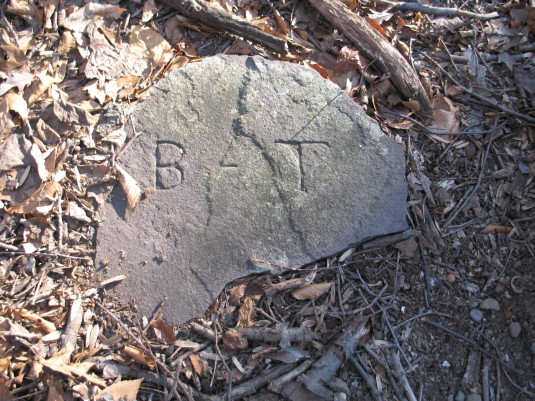 M. A. T. is most likely Mary Ann Thatcher, but I do not have anyone in my records who fits the bill. I didn’t find a stone with M. A. T. on it. What I did find clearly reads B. A. T.
M. A. T. is most likely Mary Ann Thatcher, but I do not have anyone in my records who fits the bill. I didn’t find a stone with M. A. T. on it. What I did find clearly reads B. A. T.
Perhaps there is also a stone labeled “M. A. T.” I hope so. It saddens me to think that some of the transcriptions from early cemetery hunters might be inaccurate. I depend on them for information on the stones that are no longer standing. From now on, I must take those old lists with a grain of salt. This is a good reason for protecting our old cemeteries, and documenting their contents.
M. T. might be Margaret Hull, wife of Joseph Thatcher, who bought land from Thomas Kitchen on either side of Rte 579, and built a stately house that later became the Boarshead Tavern, next to Boarshead Road. Boarshead seems a long way from the Kitchen Burying Ground, but it’s possible. She survived her husband, who died in 1791, but her death date is not known.
Stones That Don’t End in K or T
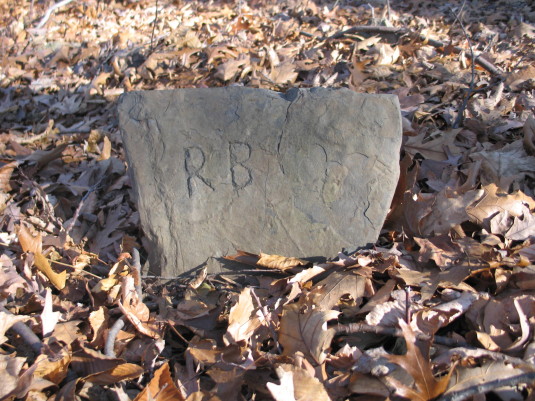 One stone in the Kitchen burial ground has the initials R. B. This might be a member of the Buchanan family which owned the hill looking over the intersection of Routes 523 and 579. The Buchanans ran a very well-known tavern in the 18th century, but I know of no Buchanan with a given name of R except Rachel, who bought a lot from John Buchanan Jr. in the 1800s.
One stone in the Kitchen burial ground has the initials R. B. This might be a member of the Buchanan family which owned the hill looking over the intersection of Routes 523 and 579. The Buchanans ran a very well-known tavern in the 18th century, but I know of no Buchanan with a given name of R except Rachel, who bought a lot from John Buchanan Jr. in the 1800s.
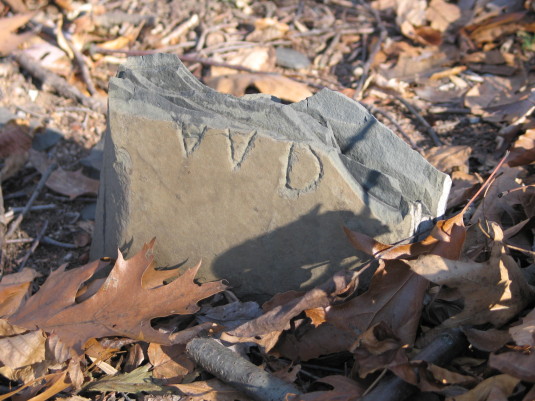
Another mystery is this stone: “M A E I A 1765.” It might mean M. A. E. died Jan. 1765. I have no clue to who this is, or to the identity of another stone: “I. F.” (I did not find either of these stones when I visited.)
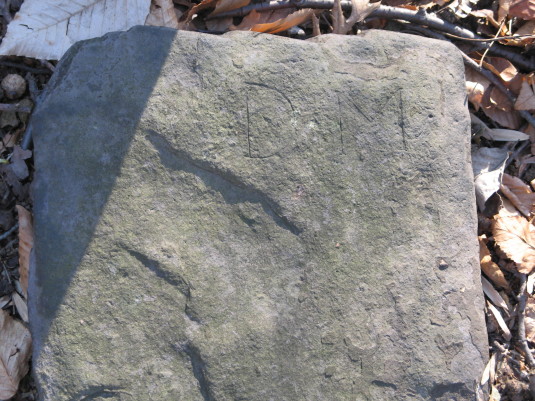

Actually, with a death date as late as 1832, it seems doubtful that John Rockafellar would have such a crude stone. His son John died in Amwell in 1811, about the age of 31. He owned land on Boarshead Road, so perhaps this is him.
S. R. 1835 might be Sarah, daughter of John Rockafellar (Sr.) and Margaret Kitchen. In his will, written in 1828, John mentioned his sons and daughters but did not name them, except for son Samuel. In fact, I do not know when Samuel died, so perhaps this stone is his.
Another possibility for the R stones is someone from the Robbins family. Daniel Robins owned the whole tract of land that the Robins Hill development stands on back in the early 1700s, and his son Isaac Robins married Azubiah Thatcher about 1720.
On the other hand, Hannah Kitchen, daughter of Thomas and Sarah Kitchen, married Vincent Robins. They had a daughter Sarah Robins who is not known to have married. But 1835 is a late date; Sarah Robins would have been at least 75 years old. The I. R. might be John Robins, son of Ann Kitchen and Vincent Robins. He died after 1789.
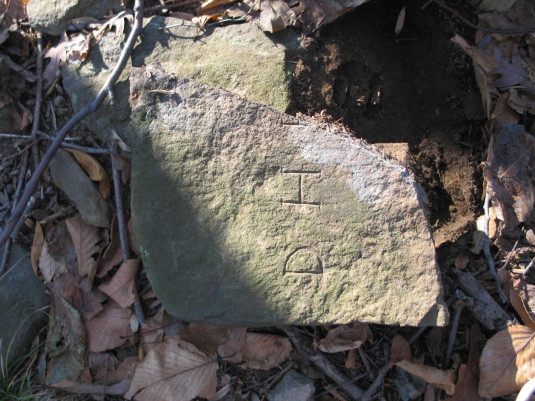
Like most of the oldest burying grounds in our township, this one would benefit from some careful preservation work. It is located near a development, which means it is more vulnerable to thoughtless damage. Sad to say, but the best way to preserve these old places is make them invisible.
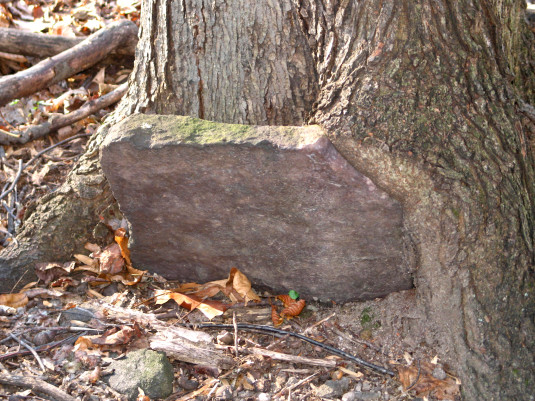
Here are a couple other stones:
Some Comments from the Delaware Twp. Post:
From Donna Hay: “I am a descendant of the Peter Vandolah, and he definitely died in Ohio, so it is not him. And, my information was that he had left NJ around 1771-1772, so it would not be a descendant of his either. But his brother Garrett was there at that time, and it could have been a descendant of Garrett’s.”
My response: If Peter Vandolah, son of Hendrick and Sarah Johnson Vandolah, left NJ in 1771 and died in Ohio, then the Peter Vandolah who died in 1806 must be someone else. He is not likely to be the son of Garret Vandolah (brother of Peter, son of Henrick) because Garret wrote his will in 1802 and made no mention whatsoever of a son Peter. Hendrick and Sarah also had a son John, but he died unmarried around 1758, as far as I can tell from his will. This is mysterious—it’s not like there were a lot of Vandolahs around in Amwell in the 18th century.
As for the record of 1792 concerning land owned by Peter Vandolah, that was a mortgage (Bk 1 pg 517) in which Samuel and Mary Hunt mortgaged land to the heirs of Amos Thatcher. Peter Vandolah bordered tracts 1 & 2 of that property.
As for Dalrymples, I don’t have a Hester Dalrymple in my database. I’ve got a couple Esther’s, but they married other people (George Salter in 1846 and John Britton in 1844). Not much help there, I’m afraid. The A. J. Dalrymple who owned the cemetery seems to have been Andrew J. Dalrymple (1843-1917), too young to be connected to Peter Vandolah who died 1806. But then again, I don’t have A. J.’s parents, so maybe there is a connection through them.
From Carla Cielo: Carla visited the graveyard and recorded these stones (she also mapped the cemetery):
R. B.
1835 S. B.
B. K.
M. A. C [?]
I. K.
T. K. D MA 20
D. M.
B. T.
D. V. 1806
Carla wondered if any of the T stones could be Trouts ?? The cemetery is located along the western edge of George Trout’s plantation.
My response: Originally it was part of the Daniel Robins land that went to Philip Calvin and Simon Myers. I doubt that Trouts are buried here. Aside from George Trout, Sr., everyone else of that name died too late.
Addendum, April 8, 2018:
Egbert T. Bush’s article, “Sand Brook Once Had A Tavern Nearby,” included a description of this cemetery. I am including it here:
“By a roundabout way we reached another old burial place, half on the Thatcher farm and half on the farm now owned by A. J. Dalrymple, who kindly piloted us to the lonely spot. Not a name is to be found on any of the numerous rough stones in this inclosure of about 50 by 30 yards, well covered by trees, but without briers or other obstacles.
A. J. Dalrymple, 1843-1917, was a farmer who married Mary E. Rittenhouse about 1866. They had one child who died young. His obituary said he lived near Sergeantsville. I have not identified exactly where he lived, but he acquired property from 1874 to 1884.3
“The following are a few of the inscriptions found:
“T K, D M, 20, 1764.” This probably means that “D K” [or T K] died March 20. 1764.
“I K”;
“S K, B Y, I U 28, 1761”;
“L. T, D O R 23, 1778”;
“M A E, I A. 1765”;
“A T, M T, M A T”;
“I T, W H A 24, 1775.”“The Thatchers and the Trouts were both early residents in this vicinity, but which the “T’ stands for, we can only conjecture, probably it stands for both; if not, then most likely for Thatcher. The “K” is thought by some to stand for Kitchen, which is not improbable; but the Kings were also near.
The original owner and miller here was Henry Kitchen, whose property was inherited by his son Samuel Kitchen. Henry was present in Sand Brook as early as the 1730’s. The hamlet is often referred to in old deeds as “Kitchen’s Mill.”
“Just beyond the enclosure, at the southerly end, are several small rough stones with no markings (tradition says that these mark the resting places of slaves whose masters are sleeping within. This lacks confirmation, but the position of the graves strongly supports the tradition. During life, slaves slept in special quarters provided for them; in death, they often slept just outside of the hallowed ground that held their owners’ dust.”
For more on the Kitchen family and Sand Brook history, see Kitchen’s Mill.
Footnotes:
- I wrote about this cemetery on the website “The Delaware Township Post.” My apologies for the small size of the photos here. ↩
- Thatcher File, Deats Genealogical Files, Hunterdon Co. Historical Society. ↩
- Andrew Johnson Dalrymple, born 1866, died before 1900, married Louisa Burkett on 11 December 1886. He was probably not the A. J. Dalrymple who gave Mr. Bush the tour of the Thatcher burying ground. ↩


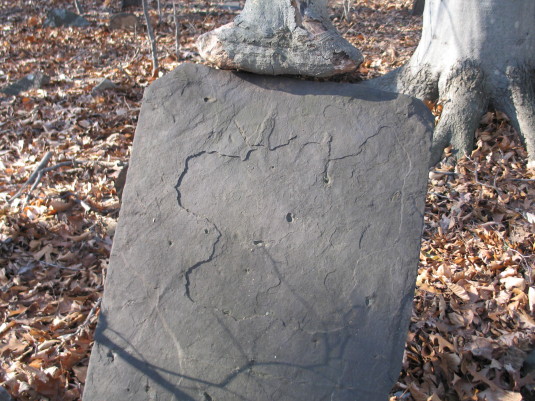
Rick Moore
June 28, 2015 @ 10:02 am
Thanks Marfy. Another interesting cemetery article. Thanks for posting this to your website.
As far as the D.M. grave, it’s possible that it may be a Moore. The name David was also prolific among my ancestors. I currently don’t know of any Moore graves that are missing who had a first initial of D. I’ll keep it in mind though during my research. I haven’t really dug into all the grand children and great grand children of Jacob and Amy (Moret) Moore yet. I’ve mostly been consumed with Daniel’s line of 20 children to this point.
It would somewhat surprise me that this person was not buried on the original Moore plantation though if they were indeed a Moore.
Kim Golding
June 28, 2015 @ 5:42 pm
You are such a wonderful family tree detective, Marfy. I am a descendant of the Amos L. Thatcher and Lydia Prall line. I wonder if you have photos of the stones you described (but did not share on the page). I do have a list of Thatcher names I will send to you. It may help you connect some names to carved initials.
Marfy Goodspeed
June 29, 2015 @ 8:11 am
Sorry Kim, I showed all the stones that I found on my visit about five years ago. No doubt there are more there, hidden under the soil.
Kim Golding
July 3, 2015 @ 2:00 pm
Which stone was L. T. D O R 23, 1778 ?
Marfy Goodspeed
July 3, 2015 @ 2:12 pm
Kim, as you can see in the article above, I did not find this stone even tho it was listed in an inventory. I hypothesize that the LT might stand for Lydia Thatcher.
Kevin Kitchen
May 23, 2016 @ 2:13 pm
Thank you for this. I have never visited New Jersey but plan on soon. I am a descendant of Samuel Kitchen’s son Henry. Henry fought in the continental army but switched sides in August 1780. He ended up in New Brunswick Canada with his two young sons. His brother William also ended up in Canada, in Ontario, but sometime after 1783. For most of us Canadian Kitchens, and there are a lot, a trip to this area is a must.
David Kirk
July 29, 2019 @ 1:03 am
Researching my half sister’s Kitchen tree, in fact all of them since the original Wheeler Kitchen.
Two worthy candidates are coming up on Facebook, are you from Milton Ontario or Brockville Ontario please?
Which of Samuel 1722-1771 sons does your line emanate from?
Regards,
David Kirk.
Marfy Goodspeed
July 29, 2019 @ 8:26 am
David, I am not a Kitchen descendant. I am a local historian, and because the Kitchen family lived in Hunterdon County, NJ, they are of interest to me. Once they leave Hunterdon, I tend to lose interest. I see you have a birth year for Samuel Kitchen. Would you mind sharing the source?
David Kirk
February 13, 2020 @ 1:52 am
I have in fact eight sources, send me an email to: dkpublic1@yahoo.co.uk
and I will send you a screen shot.
David Kirk
February 13, 2020 @ 1:37 am
Kevin, Sorry about the delay in replying, just logged in.
I have a Samuel Kitchen 1832-1908, son of Henry H Kitchen 1809-1898.
Send me an email please to this public email address I have: dkpublic1@yahoo.co.uk
Charline Gail Kitchen Ahlgreen
September 30, 2016 @ 11:10 pm
Thank you for this article. I’m a descendant of Henry through his second son, Wheeler.
Nancy Kitchen Mountford
October 6, 2016 @ 12:29 am
OMG, Marfy, thank you so much for publishing this article. I happened upon it quite by accident and was thoroughly caught up in the history of my ancestors.
Henry Kitchen(1680-1745) and Anne Wheeler (1695-1748) are my five-times great-grandparents.
Nancy Kitchen Mountford
October 6, 2016 @ 2:04 am
Oops, should be my six-times great-grandparents.
David Kirk
February 13, 2020 @ 1:41 am
I have three Nancy Kitchens all deceased on my half sister tree.
Trying to figure where you might fit in please?
My public email address is: dkpublic1@yahoo.co.uk
Shawn M. Rogers
June 19, 2018 @ 2:15 am
It is the Lower Amwell Dunkard Cemetery. According to the Abstract of Graves of Revolutionary War Burials, my 8th Great-Grandfather, Amos L. Thatcher, was buried there.
Marfy Goodspeed
June 19, 2018 @ 6:29 am
Shawn, The Lower Amwell Old Yard attached to the Dunkard Church is in a clear space with no trees growing among the graves. That is a different cemetery from the one described in this article. I would be interested to know which Amos Thatcher it is that you descend from. Can you share more information about him?
Valerie Hanada
November 29, 2019 @ 2:42 pm
thank you so much. Your research has been very helpful
Amos L Thatcher is my 6th great grandfather.
I have been trying to find information about Lydia Prall and from which Prall she descended.
It seems odd that a person from such a recognized name would not show up on any family records. I’m hoping some marriage records for Amos will show her family.
let me know
Marfy Goodspeed
November 29, 2019 @ 4:34 pm
The Prall family is a challenge to research. Lydia could very well have been the daughter of Peter Prall of Staten Island, who died there in 1748. Peter’s sons Aaron and Peter Jr. moved to Amwell Twp. They were born not long before Lydia was born. I do not know if Peter Sr. wrote a will, but that would be a good place to look.